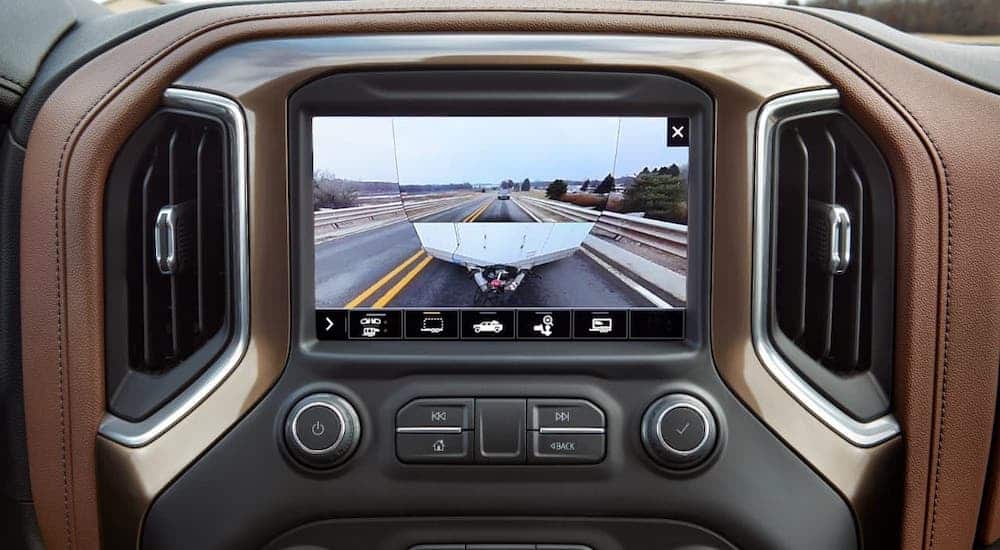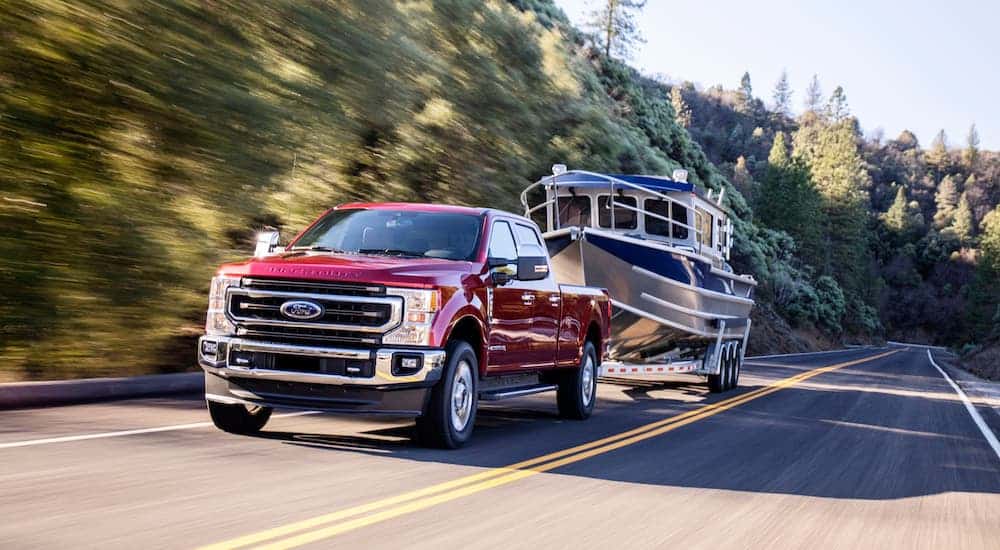Automobile manufacturers today are finding ever more innovative ways to add advanced technology to their products. And if you are looking at new three quarter ton Ford or Chevy trucks for sale, then you have probably seen advertisements for some of the new technologies that these manufacturers have developed to make trailering safer and easier than ever before. But between the Chevy Silverado 2500 and Ford F-250, which truck does have the best trailer tech? This question is not easy to answer. They both include a large number of industry standard features that make them safe and easy to drive with a trailer in tow. However, when it comes to their signature technologies, which is better is largely a matter of driver preference. The Ford Pro Trailer Backup Assist system is something that is likely to be particularly welcomed by drivers with less towing experience, but other drivers might find it pointless. Meanwhile, the Chevy advance vision system is less revolutionary, but the increased awareness that it provides will be helpful to even the most experienced drivers.
Shared Technologies
Both the Ford F-250 and Chevy Silverado 2500 share a large number of their modern towing technologies. Among the most obvious of these are their tow/haul modes and trailer brake controller systems. The brake controllers not only allow you to activate the brakes on a larger trailer by simply pushing the brake pedal on your truck; they also allow you to dial the trailer brake force up or down for optimal control. The tow/haul modes have a somewhat more subtle effect of modifying the transmission programming with strategies such as later upshifts, earlier downshifts, and locking out overdrive gears. These techniques result in better power when accelerating and more engine braking when decelerating or traveling downhill. They also cut down on the amount of time the transmission spends hunting for the correct gear, producing a smoother ride and reducing transmission wear.
A less obvious but equally important system is trailer sway control. Standard on both the Silverado 2500 and F-250, trailer sway control can sense dangerous oscillations developing in your load and activates the truck’s stability control system to return you to a steady course. Another hidden feature shared by these trucks that improves the trailering experience is hill start assist, which will temporarily continue holding the brakes to prevent the truck from rolling backwards when you switch to stepping on the gas. However, while the Ford F-250 and Chevy Silverado 2500 both share a large number of now industry-standard advanced safety features, this does not mean that all of their trailering tech is the same. Finally, both Chevy and Ford offer advanced trailering software as part of their vehicle apps. Although their features and interfaces are not the same, the software from the two manufacturers is designed to make the process of towing more convenient. This includes useful functions such as wiring and brake light checks or checklists to make sure you do not forget any steps when connecting a trailer. Of course, as with most software in existence, which one is better is mostly a matter of personal preference.

Chevy’s All-Seeing Eyes
The headline piece of trailering technology for the new 2020 Chevy Silverado 2500 is its state of the art multiview camera system. When fully equipped with a compatible trailer, this system gives the Silverado 2500 no fewer than fifteen different camera angles to simplify hitching your trailer, better view your surroundings while on the road, and even look inside your trailer itself. While even your basic backup camera can make hitching a trailer a much simpler process, Chevy has taken this to a new level with four specialized camera views designed to facilitate connecting your trailer to your Silverado 2500. These include a birds-eye surround view of the entire truck, a zoomed in top-down view of the rear of the truck, a close-up view of the trailer hitch, and finally a bed view for use with gooseneck and fifth-wheel trailers. Through the use of these four camera angles, attaching a trailer is easier than ever before.
Once on the road, the most revolutionary camera mode is Chevy’s transparent trailer view. This digitally combines the feed from cameras on the truck and on the trailer to allow you to “see-through” your trailer and get a better look at what is behind you. Another piece of digital wizardry is the pic-in-pic side view that combines the tailor camera with the truck’s side-mounted camera to give you a wider field of view behind you. And of course, you can just view the view from the trailer’s camera by itself. The Silverado 2500 also offers support for installing a camera inside the trailer, allowing you to check on your cargo without stopping. Finally, the Silverado’s camera systems provide a number of views useful for low-speed maneuvering and parking. These include views from front and side cameras that let you know just how close your truck is to any obstacles as well as provide you with clear views of your wheels to help you gauge steering angle. Altogether, Chevy’s advanced vision system gives Silverado 2500 drivers unmatched awareness when pulling a trailer.
Ford’s Robotic Reverse
The Ford F-250 sports its own advanced vision system that incorporates seven different cameras, including an optional trailer-mounted camera. However, Ford’s signature piece of advanced trailering technology is the Pro Trailer Backup Assist system. No matter how much experience you have pulling trailers and how many camera views you have available, backing up with something in tow is always a tricky and counterintuitive experience. And for drivers who only rarely haul a trailer, backing up brings risks of damage and embarrassment that renders it something best avoided entirely. This is where Ford’s cutting edge automated trailer reverse system comes into play. With it engaged, you simply tell your F-250 where you want to go and let the truck steer itself into position.
In order to use the Pro Trailer Backup Assist system, you have to first calibrate your trailer by entering its dimensions into your F-250’s computer. These details are permanently saved, and a database of up to ten different trailers can be maintained, so you do not need to worry about having to repeat this step every time you hitch up. Whenever you want to change trailers, just open the system and select a previously saved profile, and you are good to go. Once you have your trailer profile loaded, Ford’s Pro Trailer Backup Assist is enabled from a small knob on the dashboard. When you are ready to back up with a trailer in tow, just hit the button to activate the system and turn the knob in the direction that you want your truck and trailer to go. The F-250 will then calculate the necessary steering angles and turn the wheel as needed to put you there, leaving you to operate the gas and brakes. This system is extremely intuitive as it allows you to provide the same steering inputs that you would if you did not have a trailer attached, preventing you from accidentally correcting in the wrong direction and damaging your trailer and your pride.





